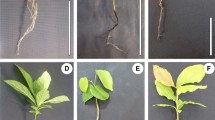Abstract
Biomass allocation and assimilation efficiency of natural Amour linden (Tilia amurensis) samplings in different light regimes were analyzed in the paper. The results showed that shoot increment of samplings in gap was the highest and that of samplings under canopy was the least. Samplings in gap expressed apical dominance strongly but samplings in full sun and under canopy behaved intensive branching. Lateral competition or moderate shading was favored to bole construction. The patters of biomass allocation of samplings in different light environment were rather similar. The biomass translocated to stem was more than that to other organs, and about one half of photosynthate was used to support leaf turn over. On the contrary, photosynthates of samplings in full sun were mostly consumed in leaves bearing and energy balancing. The carbon assimilation for leaves of samplings in gap was the most efficient, and more carbons were fixed and translocated to non-photosynthetic organs, especially to stemwood.
Similar content being viewed by others
References
Beaudet, M. and Messier, C. 1988. Growth and morphological responses of yellow birch, sugar maple, and beech seedlings growing under a natural light gradient. Can. J. For. Res.,28: 1007–1015
Callawy, R.M. 1992. Morphological and physiological responses of three California oak species to shade. Int. J. Plant Sci.,153(3): 434–441
Canham, C.D., Berkowitz, A.R. and Kelly, V.R.et al. 1996. Biomass allocation and multiple resources limitation in tree seedlings. Can. J. For. Res.,26: 1521–1530
Chapin, F.S., Bloom, A.J. and Field, C. B.et al. 1987. Plant responses to multiple environmental factors. Bio. Science,37(1): 49–57
Cornelissen, J.H.C. 1993. Aboveground morphology of shade-tolerantCastanopsis fargesii samplings in response to light environment. Int. J. Plant Sci.,154(4): 481–495.
Hu Ryntian, Ju Yonggui and Zhang Shiying. 1991. Study on the growth of young trees in mixed forests between hard-wood and conifer species. Journal of Northeast Forestry University,19 (Supplement Issue): 115–120
Igboanugo, A.B.I. 1990. Effects of shading on shoot morphology, wood production and structure ofQuercus petraea. For. Ecol. Manage.,38: 27–36.
Latham, R.E. 1992. Co-occurring tree species change. An evaluation of concepts, methods, values, and their significance. Physiol. Plant,58: 556–563.
Nie Shaoquan, Guan Wenbin and Yang Guotinget al. 1992. Research on population ecology of amour linden. Harbin: Northeast Forestry University Press, China
O’Connell, B.M. and Kelty, M.J. 1994. Crown architecture of understory and open-grown white pine (Pinus strobus L.) samplings. Tree Physiology, 14: 89–102
Putz, F.E., and Canham, C.D. 1992. Mechanisms of arrested succession in shrublands: root and shoot competition between shrubs and tree seedlings. For. Ecol. Manage.,49: 267–275
Shi Fengyou, Chen Xiquan and Chen Qaiquan. 1991. Research on the artificial mixed forest ofTilia amurensis andLarix olgensis. Journal of Northeast Forestry University,19 (Supplement Issue): 45–53.
Wang Qingcheng, Wang Zhengquan and Li Guojianget al. 1991. Study on the relationships among seedling quality and survival rate, stocking percentage and young stand growth. Journal of Northeast Forestry University,19 (Supplement Issue): 16–24
Zhou Xuezhong. 1995. Trait on planting of plantations ofFraxinus mandshurica, Juglans mandshurica andTilia amurensis in different site. Forest Science and Technology, (3): 16–1
Author information
Authors and Affiliations
Additional information
Responsible editor: Zhu Hong
Rights and permissions
About this article
Cite this article
Chengyang, X. Biomass allocation and assimilation efficiency of naturalTilia amurensis samplings in response to different light regimes. Journal of Forestry Research 10, 69–74 (1999). https://doi.org/10.1007/BF02855529
Received:
Issue Date:
DOI: https://doi.org/10.1007/BF02855529




